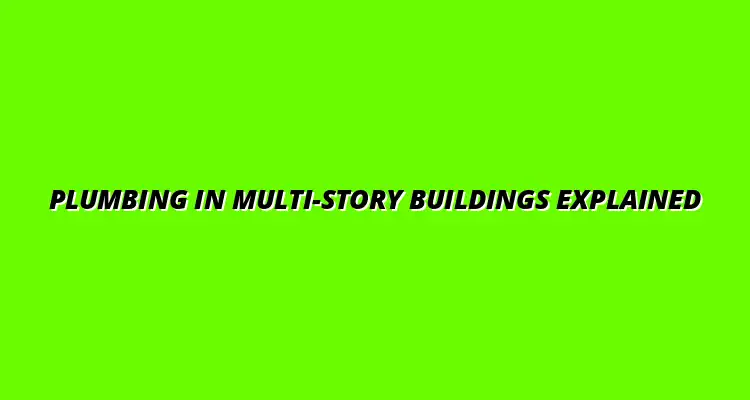
- Beginner Tips
- Jan 24
2025-01-19
When it comes to plumbing systems in multi-story buildings, understanding the fundamentals is crucial. These systems are not just about getting water in and waste out; they are complex networks that ensure efficiency and safety. Proper plumbing design can significantly affect the building's functionality and the comfort of its occupants. For a basic understanding of how residential plumbing works, check out this helpful guide on understanding residential plumbing systems.
In vertical structures, various factors come into play, such as gravity, water pressure, and the layout of pipes. As buildings grow taller, the plumbing systems become more intricate, requiring careful planning and execution. This article will explore the key elements of plumbing in these towering structures!
Plumbing in multi-story buildings involves several important components. To fully grasp how these systems work, we must first define the core aspects of plumbing within a vertical context. It encompasses everything from water supply lines to drainage systems, all designed to operate flawlessly across multiple floors. Understanding plumbing vent systems is also critical; you can learn more about them here.
In these structures, plumbing must efficiently transport water and waste while considering the unique challenges posed by height. A well-designed plumbing system ensures that water reaches the top floors with adequate pressure while effectively removing waste from the lowest levels.
In a multi-story building, plumbing serves the vital role of supplying fresh water and removing waste. It's essential for the daily operations of the building and plays a significant role in health and hygiene. The complexity of these systems grows with each additional floor. Low water pressure in your kitchen? This guide on fixing low kitchen water pressure can help.
Here's a quick definition of the key functions of plumbing in tall buildings:
Understanding the key components of plumbing systems is vital to grasp how they function. Some of the main parts include pipes, fixtures, and valves, which work in harmony to ensure everything operates smoothly. Each component has a specific role that contributes to the overall efficiency of the system. For example, preventing corrosion in your bathroom plumbing is crucial for longevity; here are some helpful tips to prevent bathroom plumbing corrosion.
Here are some essential components found in multi-story plumbing systems:
Efficient plumbing design is not just about functionality; it directly impacts water supply and waste management. A well-thought-out plumbing system minimizes water waste and ensures that all areas of the building receive adequate service. This, in turn, promotes a sustainable environment that benefits both residents and the building's longevity. Simple DIY plumbing tips can be very helpful for homeowners; check out these DIY plumbing tips for homeowners.
Moreover, an efficient plumbing system can significantly reduce costs associated with water usage and maintenance. It’s essential for building managers and owners to recognize the importance of investing in a good plumbing infrastructure!
Proper plumbing design ensures that clean water is delivered efficiently and that waste is disposed of safely. This balance is critical in multi-story buildings where plumbing networks can become quite complicated. If the design is off, it can lead to major issues like poor water pressure or backup of sewage.
Here are some impacts efficient plumbing has on water supply and waste management:
Investing in efficient plumbing design pays off in the long run. Well-designed systems often require less maintenance and can help avoid costly repairs. Additionally, regular assessments can help identify potential issues before they escalate, saving both time and money. Need a plumber in Billesley, Birmingham? Check out this resource for plumbers in Billesley, Birmingham.
Here are some considerations for cost efficiency and maintenance:
Understanding plumbing systems in multi-story buildings is crucial for everyone involved in construction and property management. A robust plumbing infrastructure not only ensures the smooth distribution of water and management of waste but also significantly impacts the overall functionality and comfort of the building. Here, I want to highlight the key points that emphasize the importance of these systems in high-rise structures.
In essence, an effective plumbing system serves as the backbone of any multi-story building, influencing both tenant satisfaction and the building's longevity. Without proper plumbing, issues can arise quickly, from minor inconveniences to major structural problems. Thus, investing in strong plumbing infrastructure is a must for any tall structure.
Having a reliable plumbing system is essential for enhancing the lifespan of a multi-story building. Here are some ways that a well-designed plumbing system contributes to this goal:
By focusing on these key areas, property owners can enhance the longevity and overall performance of their buildings. It’s essential to ensure that plumbing systems are designed with durability in mind, so they stand the test of time.
Proper plumbing directly impacts the lifespan of a building. When plumbing systems are well-maintained, they contribute positively to the overall structure. Here are some benefits:
These factors combine to create a sturdy building that can serve residents well for many years.
Another critical aspect of a robust plumbing system is its direct correlation with tenant satisfaction. Happy tenants are more likely to remain long-term, which is beneficial for property managers. Key components that contribute to this satisfaction include:
When tenants feel secure and comfortable, it enhances their overall experience, making them more likely to recommend the building to others.
In conclusion, understanding the intricacies of plumbing maintenance and design in multi-story structures is essential. The more we learn about effective plumbing systems, the better we can ensure they serve their intended purpose successfully. This knowledge can be a game changer in the long run!
Moreover, as industry standards evolve, it’s crucial for professionals to stay informed about the latest techniques and technologies in plumbing. Continuous education ensures we remain adept at tackling new challenges as they arise.
Staying updated on plumbing best practices is vital for everyone involved in managing multi-story buildings. Here are some education and awareness strategies:
These strategies not only help in understanding plumbing better but also empower professionals to make informed decisions.
Lastly, focusing on sustainable plumbing solutions is key to future-proofing our buildings. As environmental concerns grow, implementing eco-friendly practices is essential. Here are some strategies to consider:
Adopting these sustainable plumbing solutions can create a lasting positive impact on both the environment and the community. Together, we can make a difference!
